A Distributed Demand Side Energy Management Algorithm for Smart Grid
Abstract
:1. Introduction
- A novel DSM is proposed that considers minimizing the operation cost of each user as well as the discomfort caused by the change of load operation schedule. The DSM can also accommodate different types of user-preferences.
- A distributed optimization algorithm based on games theory is proposed to coordinate the users’ operation schedules to minimize their own operation costs. Meanwhile, an iteration mechanism is proposed to accelerate the convergence speed.
- An MPC framework is implemented to integrate the user operation management model and distributed optimization algorithm. The MPC framework, featuring a rolling up and feedback mechanism, is shown to be able to handle the negative impacts caused by the forecast uncertainty of the RESs output and load demand.
2. Literature Review
3. System Model and Problem Formulation
3.1. Model of Loads
3.2. Model of DERs
3.3. Energy Price Model
3.4. Power Interaction Model
3.5. Cost Model
4. MPC Based Distributed User Energy Management Strategy
4.1. Distributed User Energy Scheduling Optimization
- (i)
- Players: all users ( users) in the smart grid.
- (ii)
- Strategies: each user selects its strategy by scheduling the dispatchable units (smart loads and ESS) to minimize his/her own cost.
- (iii)
- Payoffs: the payoff for user comprises two parts, see Equation (35): the actual operation cost described in Equation (33) at iteration , and the penalty cost caused by large fluctuant of the operation routine in two successive iterations.
4.2. MPC-Based Control Framework
- (i)
- At the end of period , the EMS of user obtains the updated state of its related dispatchable units, including the energy level of ESS, , the operation status of shift-able loads, , the operation status, and power demand, of the schedulable loads. Then the EMS calculates the forecasted data of load demand, PV generation and wind production from period to .
- (ii)
- The distributed optimization model illustrated in Table 1 is solved individually for each user, reaching a Nash Equilibrium (NS), i.e., . The first sample of the control sequence is then sent to local controllers.
- (iii)
- At the beginning of , only the first sample of the control sequence is implemented. The insufficient power caused by forecast errors is compensated by the utility. On the contrary, the excess power will be sold back to the utility with a lower price. Finally, the EMS updates the parameters and forecast model with new data.
- (iv)
- Go to step (i) until the end of the simulation.
5. Simulation and Results
5.1. Experiment Setup
5.2. Simulation Results
5.2.1. Results of the DMPC Strategy and DDA Strategy
- (i)
- At the scheduling stage, the EMS determines the operation schedule of the smart load appliances and the ESS over the control horizon by implementing the distributed optimization algorithm of Table 1 at the beginning of the day with the forecasts of RESs generation and load demand. The control sequence sent to the controllers of all dispatchable units should be implemented strictly.
- (ii)
- At the real-time power compensation stage, for each user the insufficient power will be provided by the utility company at a higher price and the extra power generation will be sold at a lower price back to the utility.
5.2.2. Analysis of the Penalty Cost Term for the Utility Power Generation
5.2.3. Comparison of the Parallel and Sequential Optimization Algorithm
6. Conclusions
Author Contributions
Funding
Conflicts of Interest
References
- Strbac, G. Demand side management: Benefits and challenges. Energy Policy 2008, 36, 4419–4426. [Google Scholar] [CrossRef]
- Zhao, N.; Yu, F.R.; Sun, H. Adaptive energy-efficient power allocation in green interference-alignment-based wireless networks. IEEE Trans. Veh. Technol. 2015, 64, 4268–4281. [Google Scholar] [CrossRef]
- Palensky, P.; Dietrich, D. Demand side management: Demand response, intelligent energy systems, and smart loads. IEEE Trans. Ind. Inform. 2011, 7, 381–388. [Google Scholar] [CrossRef]
- Meng, F.L.; Zeng, X.J. A Profit Maximization Approach to Demand Response Management with Customers Behavior Learning in Smart Grid. IEEE Trans. Smart Grid 2016, 7, 1516–1529. [Google Scholar] [CrossRef]
- Ye, F.; Qian, Y.; Hu, R.Q. A real-time information based demand-side management system in smart grid. IEEE Trans. Parallel Distrib. Syst. 2016, 27, 329–339. [Google Scholar] [CrossRef]
- Beaudin, M.; Zareipour, H. Home energy management systems: A review of modelling and complexity. Renew. Sustain. Energy Rev. 2015, 45, 318–335. [Google Scholar] [CrossRef]
- Shariatzadeh, F.; Mandal, P.; Srivastava, A.K. Demand response for sustainable energy systems: A review, application and implementation strategy. Renew. Sustain. Energy Rev. 2015, 45, 343–350. [Google Scholar] [CrossRef]
- Zhang, Y.; Zhang, T.; Wang, R.; Liu, Y.; Guo, B. Optimal operation of a smart residential microgrid based on model predictive control by considering uncertainties and storage impacts. Sol. Energy 2015, 122, 1052–1065. [Google Scholar] [CrossRef]
- Prodan, I.; Zio, E. A model predictive control framework for reliable microgrid energy. Electr. Power Energy Syst. 2014, 61, 399–409. [Google Scholar] [CrossRef]
- Soliman, H.M.; Leon-Garcia, A. Game-theoretic demand-side management with storage devices for the future smart grid. IEEE Trans. Smart Grid 2014, 5, 1475–1485. [Google Scholar] [CrossRef]
- Bu, S.; Yu, F.R. A game-theoretical scheme in the smart grid with demand-side management: Towards a smart cyber-physical power infrastructure. IEEE Trans. Emerg. Top. Comput. 2013, 1, 22–32. [Google Scholar] [CrossRef]
- Aalami, H.; Yousefi, G.; Moghadam, M. Demand response model considering EDRP and TOU. In Proceedings of the 2008 IEEE/PES Transmission and Distribution Conference and Exposition, Chicago, IL, USA, 21–24 April 2008. [Google Scholar]
- Setlhaolo, D.; Xia, X.; Zhang, J. Optimal scheduling of household appliances for demand response. Electr. Power Syst. Res. 2014, 116, 24–28. [Google Scholar] [CrossRef]
- Zhang, Y.; Wang, R.; Zhang, T.; Liu, Y.; Guo, B. Model predictive control-based operation management for a residential microgrid with considering forecast uncertainties and demand response strategies. IET Gener. Transm. Distrib. 2016, 10, 2367–2378. [Google Scholar] [CrossRef]
- Erdinc, O. Economic impacts of small-scale own generating and storage units, and electric vehicles under different demand response strategies for smart households. Appl. Energy 2014, 126, 142–150. [Google Scholar] [CrossRef]
- Mohsenian-Rad, A.H.; Wong, V.W.; Jatskevich, J.; Schober, R.; Leon-Garcia, A. Autonomous demand-side management based on game-theoretic energy consumption scheduling for the future smart grid. IEEE Trans. Smart Grid 2010, 1, 320–331. [Google Scholar] [CrossRef]
- Song, L.; Xiao, Y.; van der Schaar, M. Demand side management in smart grids using a repeated game framework. IEEE J. Sel. Areas Commun. 2014, 32, 1412–1424. [Google Scholar] [CrossRef]
- Fathi, M.; Bevrani, H. Adaptive Energy Consumption Scheduling for Connected Microgrids under Demand Uncertainty. IEEE Trans. Power Deliv. 2013, 28, 1576–1583. [Google Scholar] [CrossRef]
- Tan, Z.; Yang, P.; Nehorai, A. Distributed demand response for plug-in electrical vehicles in the smart grid. In Proceedings of the 2013 IEEE 5th International Workshop on Computational Advances in Multi-Sensor Adaptive Processing (CAMSAP), St. Martin, France, 15–18 December 2013; pp. 468–471. [Google Scholar]
- Atzeni, I.; Ordóñez, L.G.; Scutari, G.; Palomar, D.P.; Fonollosa, J.R. Noncooperative and cooperative optimization of distributed energy generation and storage in the demand-side of the smart grid. IEEE Trans. Signal Process. 2013, 61, 2454–2472. [Google Scholar] [CrossRef]
- Yang, P.; Chavali, P.; Gilboa, E.; Nehorai, A. Parallel Load Schedule Optimization with Renewable Distributed Generators in Smart Grids. IEEE Trans. Smart Grid 2013, 4, 1431–1441. [Google Scholar] [CrossRef]
- Kamyab, F.; Amini, M.; Sheykhha, S.; Hasanpour, M.; Jalali, M.M. Demand response program in smart grid using supply function bidding mechanism. IEEE Trans. Smart Grid 2016, 7, 1277–1284. [Google Scholar] [CrossRef]
- Wu, C.; Mohsenian-Rad, H.; Huang, J.; Wang, A.Y. Demand side management for wind power integration in microgrid using dynamic potential game theory. In Proceedings of the 2011 IEEE GLOBECOM Workshops (GC Wkshps), Houston, TX, USA, 5–9 December 2011; pp. 1199–1204. [Google Scholar]
- Wang, Z.; Chen, B.; Wang, J.; Begovic, M.M.; Chen, C. Coordinated Energy Management of Networked Microgrids in distribution systems. IEEE Trans. Smart Grid 2015, 6, 45–53. [Google Scholar] [CrossRef]
- Stephens, E.R.; Smith, D.B.; Mahanti, A. Game theoretic model predictive control for distributed energy demand-side management. IEEE Trans. Smart Grid 2015, 6, 1394–1402. [Google Scholar] [CrossRef]
- Chen, C.; Wang, J.; Heo, Y.; Kishore, S. MPC-Based Appliance Scheduling for Residential Building Energy Management Controller. IEEE Trans. Smart Grid 2013, 4, 1401–1410. [Google Scholar] [CrossRef]
- Kriett, P.O.; Salani, M. Optimal control of a residential microgrid. Energy 2012, 42, 321–330. [Google Scholar] [CrossRef]
- Arriagada, E.; López, E.; Roa, C.; López, M.; Vannier, J.C. A Stochastic Economic Dispatch Model with Renewable Energies Considering Demand and Generation Uncertainties. In Proceedings of the 2013 IEEE Grenoble Conference, Grenoble, France, 16–20 June 2013; pp. 1–6. [Google Scholar]
- Wang, M.Q.; Gooi, H.B. Spinning reserve estimation in micro grids. IEEE Trans. Power Syst. 2011, 26, 1164–1174. [Google Scholar] [CrossRef]
- Li, F.; Zhang, L.Z.; Wang, Y.Y.; Feng, J.S. Research on wind power integration capacity of hydro-thermal-wind power system with energy storage system. Appl. Mech. Mater. 2014, 448, 2309–2315. [Google Scholar] [CrossRef]
- Parisio, A.; Rikos, E.; Glielmo, L. A model predictive control approach to microgrid operation optimization. IEEE Trans. Control Syst. Technol. 2014, 22, 1813–1827. [Google Scholar] [CrossRef]
- Chavali, P.; Yang, P.; Nehorai, A. A distributed algorithm of appliance scheduling for home energy management system. IEEE Trans. Smart Grid 2014, 5, 282–290. [Google Scholar] [CrossRef]
- Netz, J.S. Price regulation: A (non-technical) overview. Encycl. Law Econ. 2000, 3, 1396–1465. [Google Scholar]
- Osborne, M.J.; Rubinstein, A. A Course in Game Theory; MIT Press: Cambridge, MA, USA, 1994. [Google Scholar]
- Li, N.; Chen, L.; Low, S.H. Optimal demand response based on utility maximization in power networks. In Proceedings of the 2011 IEEE Power and Energy Society General Meeting, Detroit, MI, USA, 24–29 July 2011; pp. 1–8. [Google Scholar]
- Weber, T.A. Oxford Handbook on Pricing Management; Oxford University Press: New York, NY, USA, 2010. [Google Scholar]
- Available online: http://www.elia.be/en/about-elia (accessed on 16 December 2018).
- Löfberg, J. YALMIP: A toolbox for modeling and optimization in MATLAB. In Proceedings of the 2004 IEEE International Symposium, New Orleans, LA, USA, 2–4 September 2004; pp. 284–289. [Google Scholar]

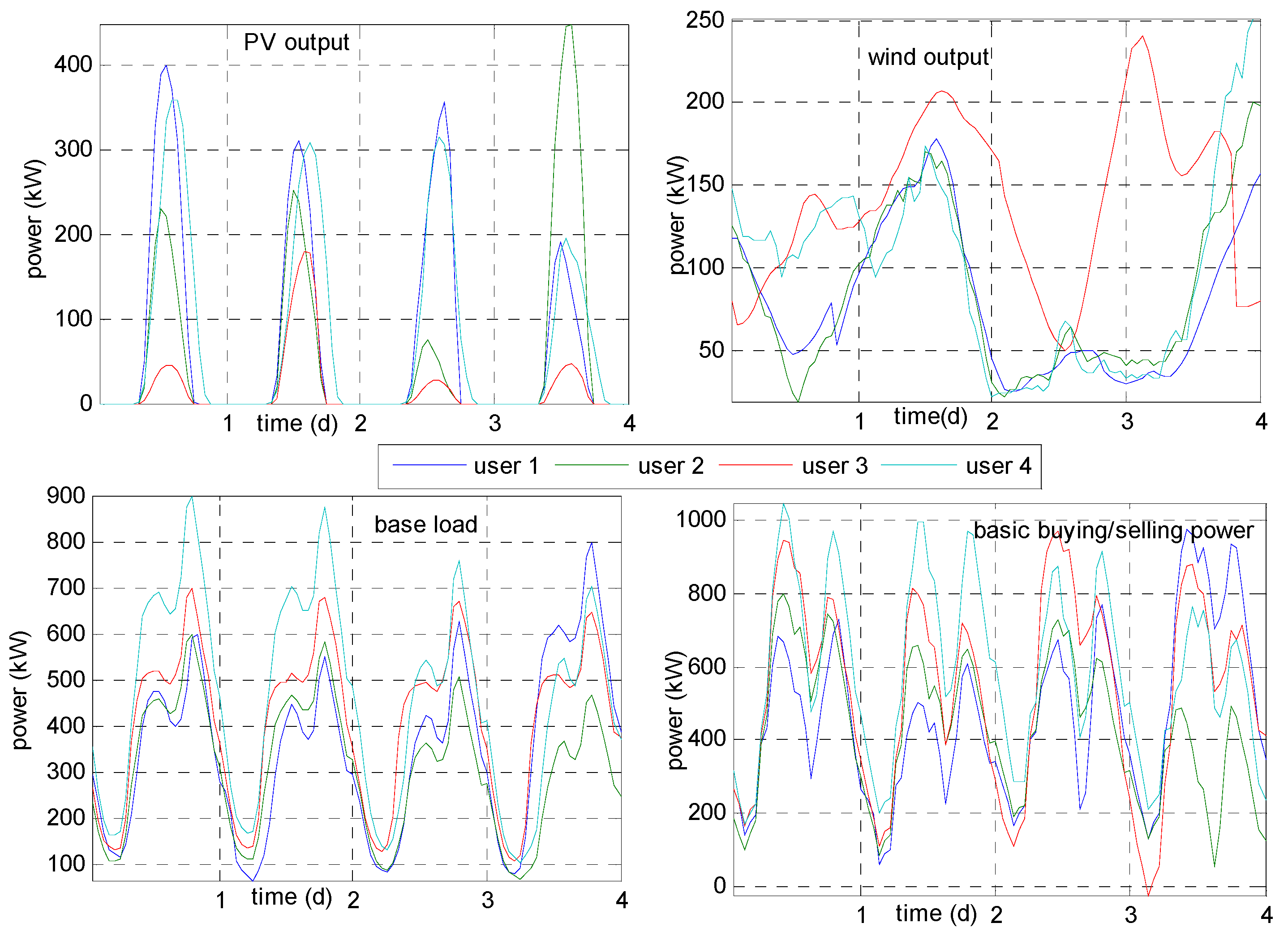
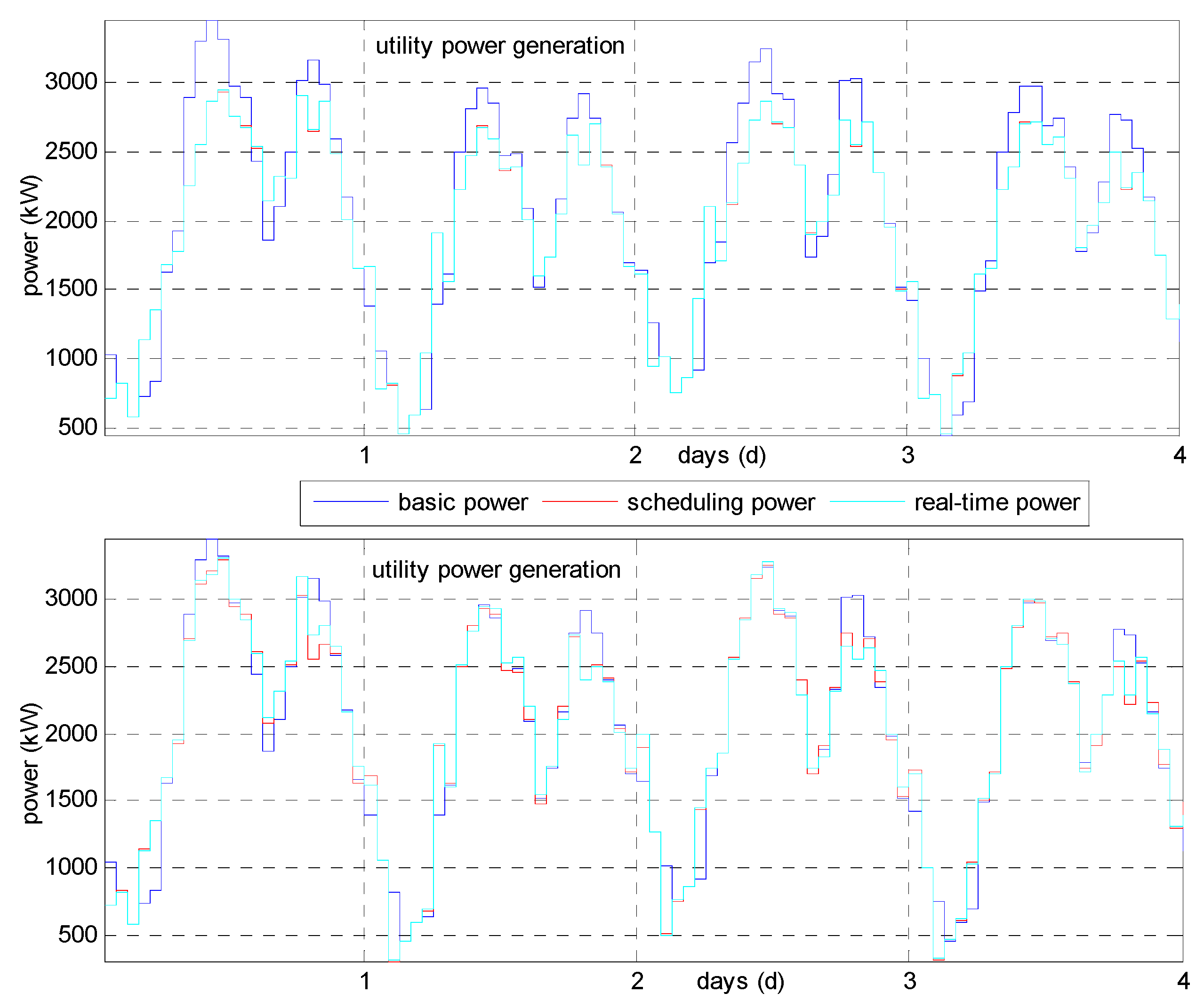
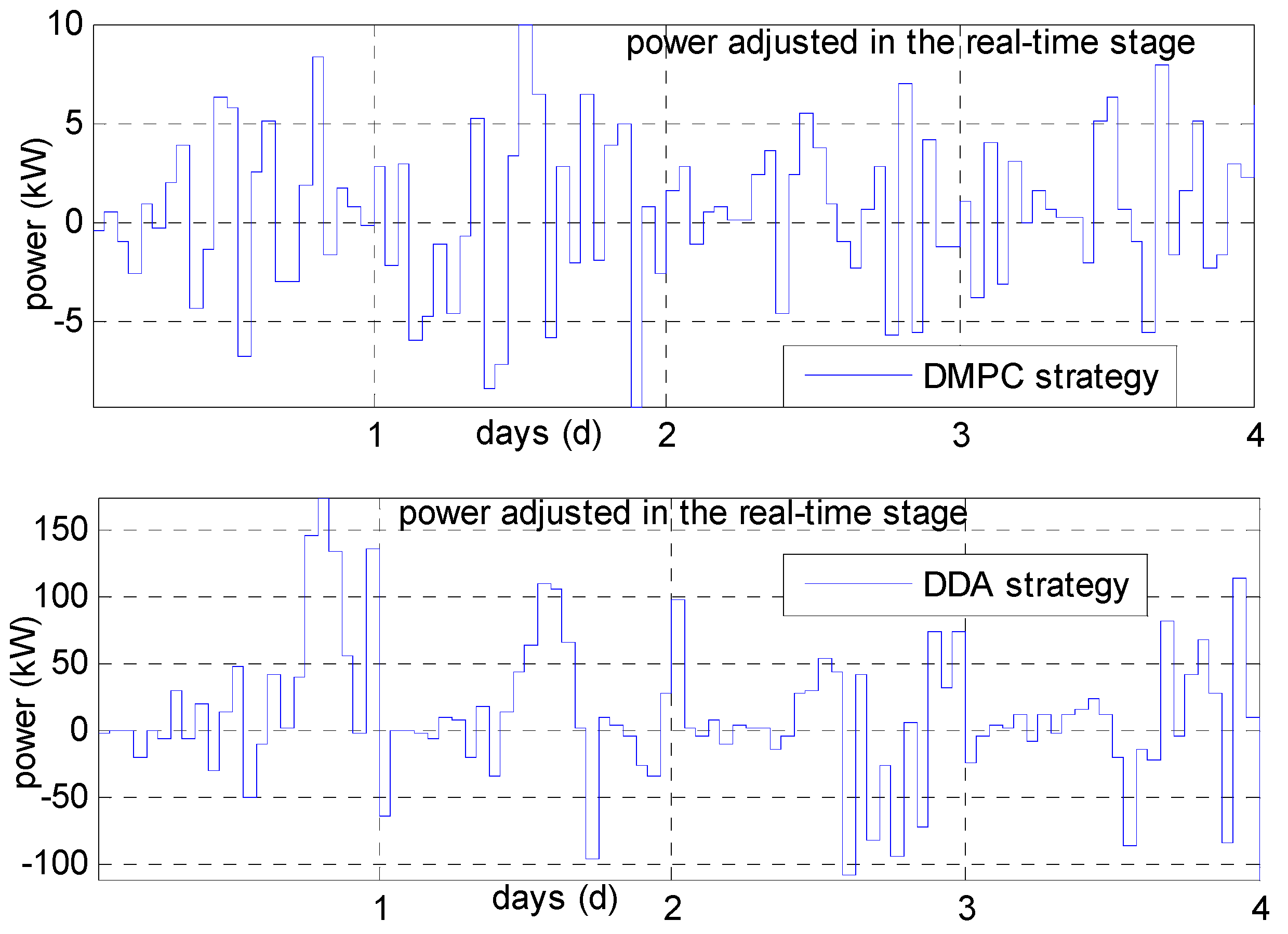
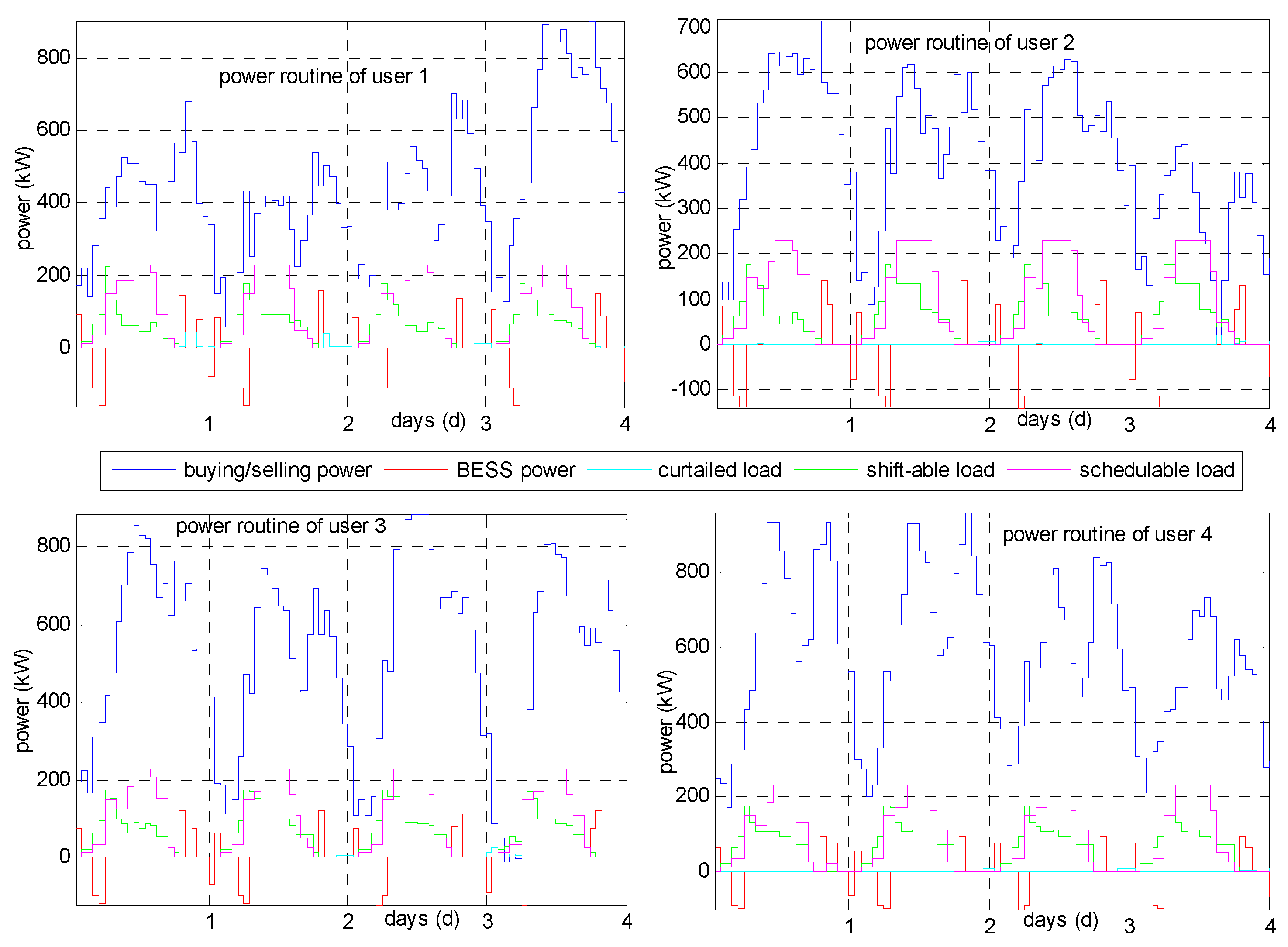
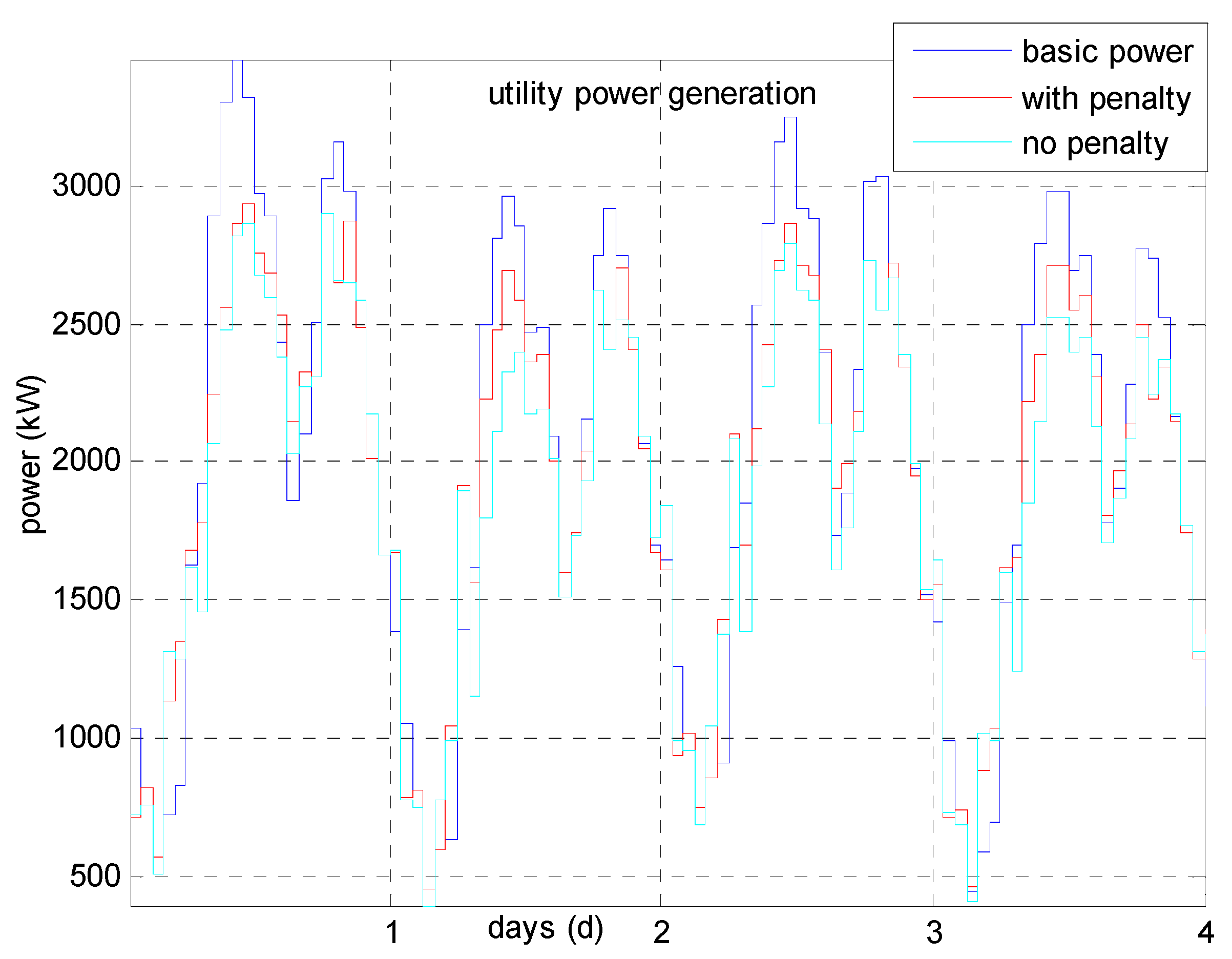

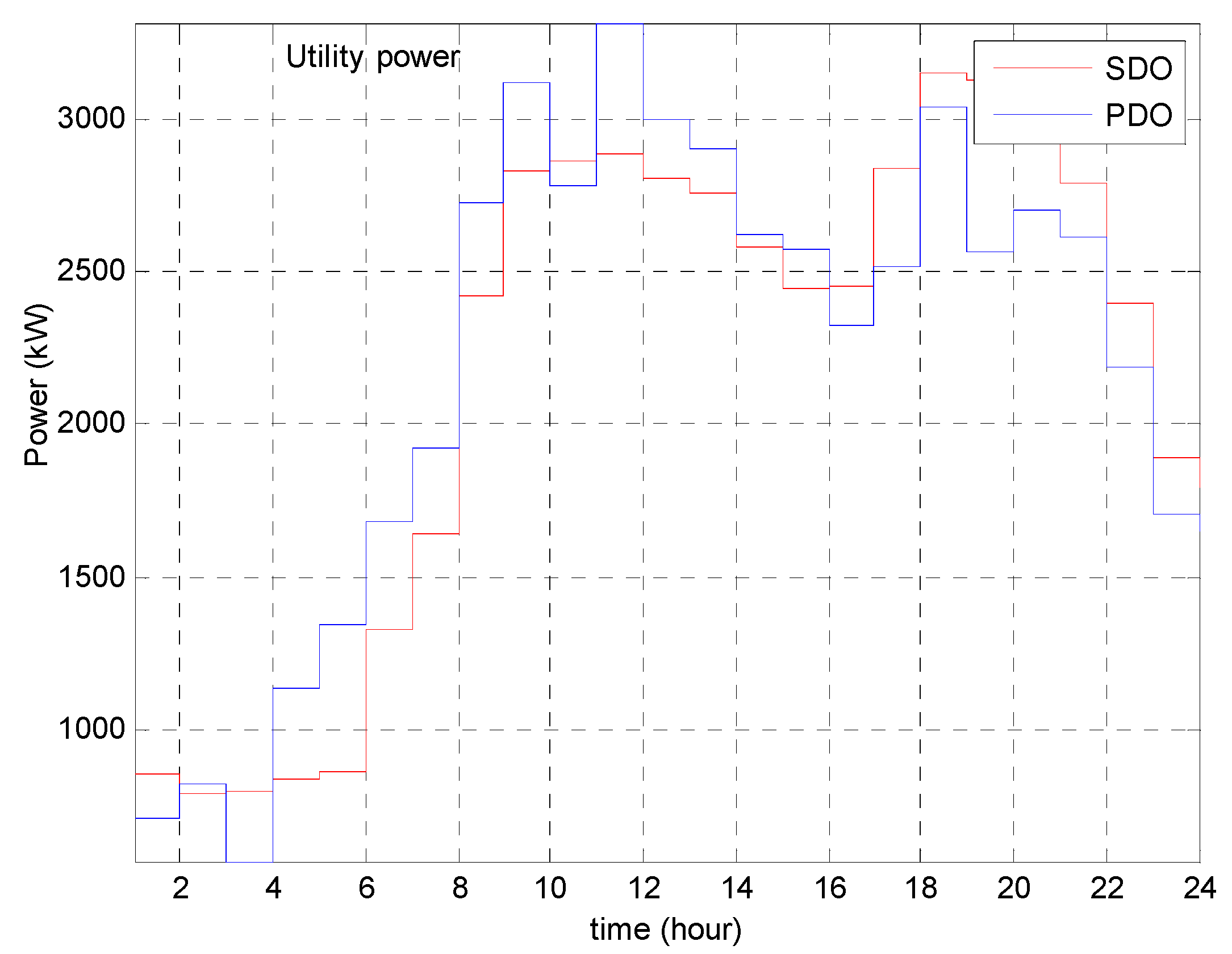
| Algorithm: for user |
|---|
| Begin |
| Initialize the iteration counter ; |
| Initialize , according to the base load scheme and forecasts; Send , to the utility control center; Repeat update the received buying and selling electricity price , from the utility control center; minimize the payoff shown in Equation (35) and calculate the newly operation schedule for all dispatchable units. send newly buying/selling power schedule , to the utility control center; ; |
| Till , , ,, |
| end |
| User | PV Plant | Wind Farm | PCC Node | Base Load |
|---|---|---|---|---|
| 1 | 400 | 200 | 1200 | 800 |
| 2 | 450 | 200 | 1000 | 600 |
| 3 | 350 | 240 | 1200 | 700 |
| 4 | 360 | 250 | 1500 | 900 |
| Shift-able Load | Power Demand (kW) | Operation Interval (h) | Duration (h) | Penalty Coefficient ($) |
|---|---|---|---|---|
| Task 1 | 22 | 15–21 | 2 | 0.1, 0.32, 0.42, 0.32 |
| Task 2 | 28 | 14–23 | 4 | 0.4, 0.34, 0.34, 0.24 |
| Task 3 | 45 | 8–18 | 6 | 0.35, 0.25, 0.29, 0.15 |
| Task 4 | 37.5 | 6–24 | 8 | 0.28, 0.18, 0.15, 0.25 |
| Task 5 | 12 | 2–22 | 12 | 0.35, 0.24, 0.26, 0.26 |
| Task 6 | 60 | 8–22 | 7 | 0.34, 0.35, 0.35, 0.37 |
| Task 7 | 75 | 6–24 | 9 | 0.36, 0.17, 0.36, 0.19 |
| Task 8 | 24 | 4–20 | 4 | 0.27, 0.35, 0.35, 0.34 |
| Load | Base Power | Max, Min Power | Time Window | Duration | Start Delay Penalty | Power Change Penalty |
|---|---|---|---|---|---|---|
| Task 1 | 25 | 15, 35 | 6–24 | 9 | 0.2, 0.27, 0.34, 0.26 | 0.11, 0.08, 0.05, 0.11 |
| Task 2 | 56 | 15, 105 | 6–16 | 6 | 0.4, 0.1, 0.33, 0.27 | 0.05, 0.1, 0.1, 0.07 |
| Task 3 | 20 | 5, 45 | 2–24 | 12 | 0.25, 0.36, 0.37, 0.25 | 0.05, 0.06, 0.11, 0.04 |
| Task 4 | 45 | 15, 105 | 4–24 | 15 | 0.28, 0.26, 0.26, 0.35 | 0.1, 0.06, 0.056, 0.05 |
| Task 5 | 30 | 12, 60 | 5–24 | 13 | 0.36, 0.15, 0.28, 0.37 | 0.07, 0.09, 0.07, 0.1 |
| Max Charge/Discharge Power | Min Charge/Discharge Power | Max Energy Level | Min Energy Level | |
|---|---|---|---|---|
| user 1 | 160 | 5 | 320 | 64 |
| user 2 | 140 | 8 | 300 | 60 |
| user 3 | 120 | 6 | 260 | 50 |
| user 4 | 100 | 4 | 220 | 40 |
| User | Scheduling Cost for MPC Strategy ($) | Adjustment Cost for MPC Strategy ($) | Scheduling Cost for DDA Strategy ($) | Adjustment Cost for DDA Strategy ($) |
|---|---|---|---|---|
| User 1 | 4.876 × 104 | 147.3 | 4.876 × 104 | 2.158 × 103 |
| User 2 | 4.390 × 104 | 163.847 | 4.400 × 104 | 1.415 × 103 |
| User 3 | 5.690 × 104 | 203.79 | 5.692 × 104 | 1.74 × 103 |
| User 4 | 6.023 × 104 | 143.954 | 6.023 × 104 | 2.727 × 103 |
© 2019 by the authors. Licensee MDPI, Basel, Switzerland. This article is an open access article distributed under the terms and conditions of the Creative Commons Attribution (CC BY) license (http://creativecommons.org/licenses/by/4.0/).
Share and Cite
He, M.-f.; Zhang, F.-x.; Huang, Y.; Chen, J.; Wang, J.; Wang, R. A Distributed Demand Side Energy Management Algorithm for Smart Grid. Energies 2019, 12, 426. https://doi.org/10.3390/en12030426
He M-f, Zhang F-x, Huang Y, Chen J, Wang J, Wang R. A Distributed Demand Side Energy Management Algorithm for Smart Grid. Energies. 2019; 12(3):426. https://doi.org/10.3390/en12030426
Chicago/Turabian StyleHe, Min-fan, Fu-xing Zhang, Yong Huang, Jian Chen, Jue Wang, and Rui Wang. 2019. "A Distributed Demand Side Energy Management Algorithm for Smart Grid" Energies 12, no. 3: 426. https://doi.org/10.3390/en12030426
APA StyleHe, M.-f., Zhang, F.-x., Huang, Y., Chen, J., Wang, J., & Wang, R. (2019). A Distributed Demand Side Energy Management Algorithm for Smart Grid. Energies, 12(3), 426. https://doi.org/10.3390/en12030426





